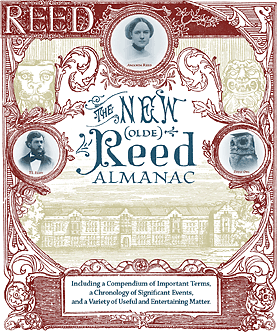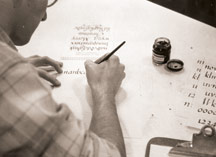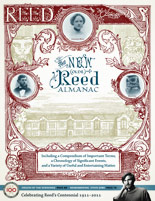
IRIS login | Reed College home Volume 90, No. 4: December 2011
The New (Olde) Reed Almanac
An irreverent compendium of the ideas, episodes, people, and traditions that have shaped Reed in the last 100 years.
Edited by Chris Lydgate ’90
As every classmate knows, Reed is one of a kind. So rigorous are its classes, so intense its atmosphere, so dramatic its history, so mind-bending its traditions, that years after graduating many of us are still trying to figure it all out. This modest almanac is intended as a handy guide for everyone who ever tried to prove that 1+1=2, suffered through Hum 110, lived in the Asylum Block, agitated for black studies, scoffed at the Quest, chortled at underwater basket weaving, procrastinated in the Paradox Café, sweated over cogito ergo sum, argued about Olde Reed, relied on financial aid, frolicked in the magic grove, earned timê, played rugby, fought for the Doyle Owl, or marched in thesis parade. Plus we have entries on ghosts, 12 noon, Paul Bragdon, Chunk 666, communism, atheism, free love, and the Seventies.
This project represents many hours of labor by dedicated staff and tireless volunteers, but it remains a work in progress. If you spot errors, see room for amplification, or just feel like rewriting an entry, we invite you to go ahead and dive into the Open Almanac, our bold experiment in community journalism. Or send peppery expostulations to reed.magazine@reed.edu. — CL
![]()
1 + 1 = 2: Almost nothing is as simple as it looks, not even the elementary statement 1 + 1 = 2. Sure, it seems obvious. But, go ahead and prove it. This fiendish problem—demonstrating the simplest equation of all time—was the killer question on the final exam of Math 113, Construction of Real Numbers, which introduced generations of Reedies to the thrill of rigorous mathematics. Created by Lloyd Williams ’35 [mathematics 1947–81] and John Leadley [mathematics 1956–93], Math 113 was long considered one of the most demanding freshman courses taught anywhere in the country. (We recently dug up a sheaf of old notes and were soon hopelessly mired in the Peano-Henkin-Lawvere Axiom.)
12 noon: For many years, Reed faculty decreed that theses were due on the last Friday in April at noon—no exceptions. However, Ellen Knowlton Johnson ’39 [registrar 1945–81] hated to turn away frantic seniors who dashed in a few minutes late. On occasion, she was known to unplug the office clock just before noon and accept theses “on time” until she went home for the day.
Almanac: An arbitrary compendium of fact and fancy compiled by fortune-tellers, magazine editors, and other harmless cranks. Not to be confused with serious works of reference such as dictionaries, encyclopedias, or even worse, official histories.
Alumni: A subterranean network of far-flung visionaries poised to take over the world. President William T. Foster (q.v.) took a surprisingly dim view of the whole concept of alumni, believing that they kept colleges handcuffed to tradition and “seem to feel that their chief business is to keep the college exactly as it was in the halcyon days of their youth.” Of course, that was before the invention of Reed alumni, whose halcyon days lie in the future. Seriously, though, Foster does not seem to have anticipated the enormous role alumni would eventually play in shaping Reed’s destiny, both by their accomplishments and by their contributions.
Anthropology: The study of the human family and its misbehavior. The discipline did not actually gain its own department until 1948, roughly coinciding with the (re)arrival of David French ’39, a pioneer in the field of linguistic anthropology. Classic courses have included Systems of Magic, The Anthropology of Millenarianism, Time and Space, and The Moral Symbolism of Eating (we feel hungry already). Anthro majors at Reed undergo a blindfold initiation rite in which they are paraded through the canyon and drink the blood of their ancestors (actually V8, we think). Influential profs (q.v.) have included Alexander Goldenweiser [1933–39], David French ’39 [1947–88], Gail Kelly ’55 [1960–2000], Claude Vaucher [1963–94], Kathrine (Kay) French [1981–2006], John Haviland [1986–2005], Robert Brightman ’73 [1989–], Rupert Stasch ’91 [1998–2009], Charlene Makley [2000–], and Paul Silverstein [2000–].
Art: A rigorous and uncomfortable discipline requiring students to stand in a room and stare at a naked body. Art was offered in Reed’s early years but then disappeared from the catalogue, not rematerializing until 1935, when the college began to offer courses on sculpture, drawing, materials and methods, and of course, art history, where the naked people can’t stare back at you. Intriguing courses have included Medieval Manuscript Illumination, The Book as Sculptural Object, Visual Art in Cold War Culture, and Iconoclasm. Influential profs (q.v.) have included Lloyd Reynolds [1929–69], Marianne Littman [1945–51], Charles Rhyne [1960–97], Willard Midgette [1963–71], Robert Palladino [1969–84], Peter Parshall [1971–2000], Scott Sonniksen [1975–82], Greg Ware [1979–89], Michael Knutson [1982–], William Diebold [1987–], Geraldine Ondrizek [1994–], James Van Dyke [2000–07], Dana Katz [2005–], and Akihiko Miyoshi [2005–].
Asylum block: A dysphemistic term for the Foster-Scholz dorms, built in 1955. (Also sometimes applied to MacNaughton.) While many inmates have shuddered at the spare design and the long hallways, others remember the dorms fondly and feel they promote solidarity because they are impossible to traverse without bumping into someone. Architectural historians consider Foster-Scholz a strong example of modernist design. Of course, they never had to live there.
Atheism: See communism.
Ballantine, Duncan [prez 1952–54]: MIT historian who came to Reed bent on reforming the college’s old-fashioned governance structure and reining in its unruly students. He nullified the faculty constitution and pursued an active role in student discipline, traditionally the domain of the student council. These attempts aroused fierce resistance from professors and students. Tension was further inflamed when three Reed professors were publicly denounced as communists. Ballantine suspended art professor Lloyd Reynolds and fired philosophy professor Stanley Moore, outraging the faculty, which passed a motion of no confidence. Ballantine resigned and went on to serve as president of the American College for Girls in Istanbul, Turkey.
Biology: Science involving dilly-dallying with worms, slime, frogs, spiders, ferns, fussy microscopes, and monster textbooks. Biologists fall into two distinct species: those who study whole organisms, and those who focus on transactions at the cellular and subcellular levels. The whole-organism camp appears to have had the upper hand in the early days, offering courses on physiology and embroyology, but the microscope mob struck back in 1918, teaching courses on histology, cytology, and bacteriology. Other intriguing courses have included Exercise Physiology; Cambrian Zoology; and Osteology of the Reptiles, a class on the crucial subject of dinosaurs and how cool they are. Influential profs (q.v.) have included Harry Beal Torrey [1912–20], L.E. Griffin [1920-45], Milo Clare [1925–37], Ralph Macy [1942–55], Frank Hungate [1946–52], Lewis Kleinholz [1946–80], Helen Stafford [1954–87], Laurens Ruben [1955–92], Frank Gwilliam [1957–96], Gabriel Lester [1961–72], Bert Brehm [1962–93], Peter Russell [1972–2011], Steve Arch [1972–], Maryanne McClellan [1981–], Bob Kaplan [1983–], David Dalton [1987–], Steven Black [1989–], Janis Shampay [1990–], Keith Karoly [1994–], and Jay Mellies [1999–].
Black studies: The study of the history, politics, culture, and literature of Africa and the African diaspora. Various departments at Reed offered courses on these topics over the years—the anthro department taught a class on ethnic relations in the forties—but never in a unified or systematic way. In the ’60s, however, concerns over “relevance,” combined with a rising number of black students on campus, sparked a student campaign for black studies, culminating in the occupation of Eliot Hall in 1968. Proponents argued that black studies were essential to a modern curriculum. Opponents argued that black studies, however important and desirable, were simply not a fundamental component of the liberal arts, from which Reed strayed at its peril. The faculty narrowly approved the program by a vote of 55-53 and hired Portland journalist and historian William McClendon to run it. The program offered courses in literature, history, politics, philosophy, sociology, and anthropology, but was never fully merged into the curriculum, and was discontinued in 1975. Since then, courses on the subject have migrated back to their original departments, e.g. English 356, The Art of the African American Short Story; or History 369, Slavery and Freedom in the Native American Southeast.
Bragdon, Paul [prez 1971–88]: Bragdon arrived at Reed in an atmosphere of financial crisis. A lawyer and Marine Corps veteran, Bragdon had served as press secretary to Mayor Robert Wagner of New York City, and worked as vice president of New York University. Inheriting a meager endowment—at $4.4 million, it was barely half of Amanda Reed’s original bequest, adjusted for inflation—Bragdon sought to shore up finances while prudently investing in academic expansion. Achievements during his tenure include departmental status for Spanish, majors in Asian studies along with art and history, restoration of the senior symposium, new visiting professorships and faculty chairs, enlargement of Hauser Library and establishment of the Cooley Gallery, construction of Vollum College Center and a studio art building, and pioneering programs in computing and educational technology. Toward the end of his presidency, Bragdon had to grapple with the fractious issue of divestment (q.v.). Although investment decisions were actually made by the trustees, Bragdon became the target of much student ire, and in 1985 his office was occupied by student protestors. Nonetheless, his Campaign for Reed raised $65 million, and he left the college with a remarkable 16-fold increase in endowment. By the time he retired, Bragdon had handed diplomas to 40 percent of all Reed graduates. Bragdon later served as president of the Oregon Graduate Institute and was then called out of retirement to be interim president of Lewis & Clark College. He and his wife, Nancy, an educator and author, continue to make Portland their home.
Calligraphy: From the Greek καλλιγραϕία, literally “beautiful writing.” A practice brought to the college by visionary professor Lloyd Reynolds [English and art 1929–69], whose humanistic philosophy and sweeping, interdisciplinary approach to education and life continue to influence the Reed ethos to this day. Reynolds was exacting in his approach, relentlessly drilling students on proper letter forms, pen angle, and the significance of text in design. Students responded to the challenge with enthusiasm, embracing the convergence of art, history, literature, and philosophy inherent in Reynolds’s teaching. For decades, Reedies hand lettered an extraordinary number of banners, cards, programs, menus, and posters all over campus, leading to a Zen-like reverence for the art of letter writing. Reynolds’s successor, Robert J. Palladino, carried the torch for an additional 15 years, until the faculty voted to drop the course in 1984. A very brief list of notable devotees would include poet Philip Whalen ’51, software guru Peter Norton ’65, type designer Chuck Bigelow ’67, and computing pioneer Steve Jobs.
Canyon: From its humble beginnings as a waterlogged cow pasture, the Reed canyon now flourishes as a cenfterpiece of campus life. Home to an extraordinary variety of plants and wildlife, the canyon contains the headwaters of Crystal Springs Creek and Reed Lake—deemed the oldest natural lake in Portland. The 28-acre watershed, which runs east to west through the heart of campus, was the site of a community swimming hole (dug in 1915 and enhanced in 1929 by the dam whose vestiges make up the land bridge), a swimming pool, muddy tug-of-war bouts, short-lived canoeing expeditions, ice skating, and thesis research. Since 1913, students and staff have come together to get their hands dirty on Campus/Canyon Day to preserve and restore its beauty. The college has also mounted an extraordinary effort to restore the canyon’s ecology to a self-sustaining condition by clearing invasive species, building a fish ladder, meandering the stream, and improving the culvert underneath Southeast 28th Avenue. As a consequence, many of the canyon’s original inhabitants have returned, including blue herons, steelhead trout, coyotes, and bald eagles.
Catalogue of ships: Monstrous passage in book two of the Iliad listing the various Greek ships, crews, and captains who joined the great expedition to Troy. Although many alumni will admit they skipped the section, the title remains powerfully evocative and functions as a nostalgic talisman when Reedies encounter one another in faraway places.
Chemistry: Science investigating the interaction of matter and energy at the atomic level with an eye to blowing things up. For many years, Organic Chemistry had a particularly fearsome reputation, possibly because it was a requirement for bio majors and premed students. Scanning through the catalogue, it is hard to think of a discipline with more intimidating course titles. Some of our favorites include Economic Chemistry, Chemical Thermodynamics, Organometallic Chemistry, Polymer Chemistry, and Environmental Chemistry. Influential profs (q.v.) have included William Conger Morgan [1911–20], Ralph Strong [1920–34], Arthur Scott [1923–79], Walter Carmody [1926–41], Fred Ayres [1940–70], Frank Hurley [1942–51], Joseph Bunnett [1946–52], Arthur Livermore [1948–65], Marsh Cronyn ’40 [1952–89], John Hancock [1955–89], Frederick Tabbutt [1957–71], Michael Litt [1958–66], Tom Dunne [1963–95], William Weir [1968–83], Larry Church [1973–80], Ron McClard [1984–], Dan Gerrity [1987–], Arthur Glasfeld [1989–], Alan Shusterman [1989–], Pat McDougal [1990–], and Maggie Geselbracht [1993–].
Cherry blossoms: Beacons of floral hope to generations of students, the Japanese flowering cherry trees of Eliot Circle put on a spectacular show each spring when the gloom of winter finally relaxes its grip. For a few precious weeks the circle explodes into a wonderland of pale pink petals, which fall earthward in snow-like flurries, drifting ankle-deep on the sidewalks. The five trees closest to Eliot make up the original planting of Prunus serrulata, which occurred sometime in the 1980s. More trees were planted the following decade.
Chinese: The language and culture of the greatest civilization ever known. Courses on Chinese history, religion, art, and anthropology were offered at Reed for many decades, but it was not until 1990 that Chinese got its own department, thanks to gifts from benefactors and the Andrew J. Mellon Foundation. Intriguing course titles include Uses of the Supernatural in Classical Chinese Literature, Text and Tradition of the Book of Change, Visions of a Madman: Modern Chinese Fiction in the Republican Period, and The Social Life of Poetry in the Tang Dynasty. Influential profs have included Charles Wu [1988–2002] and Hyong Rhew [1988–].
Chunk 666: Postapocalyptic bicycle gang renowned for welding highly unstable, excessively terrifying, frequently flaming tall bikes, choppers, and other velomutations. Often seen riding the streets of Portland clad in salvaged kitchen equipment, spandex, and bucket helmets. Tall-bike jousting remains a staple of Renn Fayre, thanks to founding member Megulon-5 (also known as Karl Anderson ’95).
Classics: The language and culture of the greatest civilizations ever known. From the beginning, Reed has boasted an outstanding tradition in the classics. In 1914, Antigone was actually presented in Greek. For many years, only Greek was offered as an elementary course since it was expected that students would have learned Latin in high school! Beyond the hallowed names that echo down the millennia, the department at Reed has offered intriguing courses such as Comedy, Epic, Satire and Tragedy; Gender, Sexuality, and the Ancient World; and Greek Sanctuaries and Festivals. Influential profs (q.v.) have included Kelley Rees [1912–20], Laurence Hartmus [1930–39], Frederic Peachy [1956–82], Richard Tron [1961–2003], Wally Englert [1981–], Nigel Nicholson [1995–], and Ellen Millender [2002–].




LATEST COMMENTS
steve-jobs-1976 I knew Steve Jobs when he was on the second floor of Quincy. (Fall...
Utnapishtim - 2 weeks ago
Prof. Mason Drukman [political science 1964–70] This is gold, pure gold. God bless, Prof. Drukman.
puredog - 1 month ago
virginia-davis-1965 Such a good friend & compatriot in the day of Satyricon...
czarchasm - 4 months ago
John Peara Baba 1990 John died of a broken heart from losing his mom and then his...
kodachrome - 7 months ago
Carol Sawyer 1962 Who wrote this obit? I'm writing something about Carol Sawyer...
MsLaurie Pepper - 8 months ago
William W. Wissman MAT 1969 ...and THREE sisters. Sabra, the oldest, Mary, the middle, and...
riclf - 10 months ago